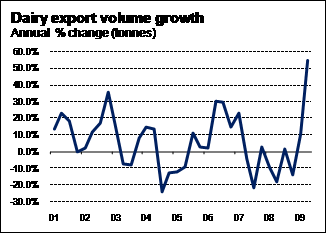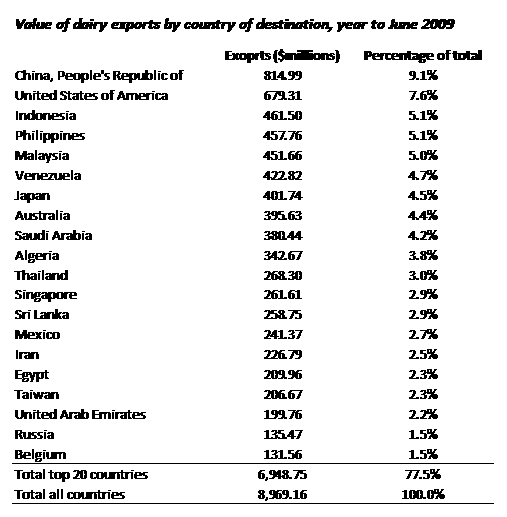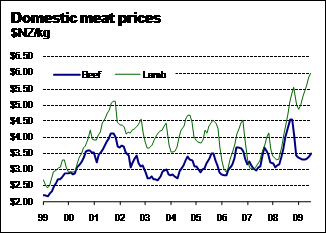We’re still an agricultural economy at heart
No matter which way you look at it, agriculture is big business for New Zealand’s economy. Together dairy and meat accounted for 34% of the total value of exports for the year to June 2009. There are also spin-off benefits to the economy from having a thriving agricultural sector, including intellectual property that is licensed offshore. Much of the recent talk about economic recovery has centred on household spending, but a strong agricultural sector will be required to underpin any sustainable growth on the other side of the recession. This article looks at the recent trends and future prospects for the dairy and meat industries, and specifically at the recent jump in lamb prices.
Dairy farmers have now long put the 2007/08 drought behind them, with pastures having recovered across much of the country. The particularly severe and widespread nature of the 07/08 drought came at an unfortunate time for dairy farmers. The dairy pay out had peaked (unbeknown to farmers at the time) at an impressive level, but most were desperately short of grass and feed. Production suffered greatly in the second half of the season, costing the wider economy dearly. The drought was a key reason why New Zealand’s economy entered recession earlier than the rest of the world.

Graph 1.1
A casual glance at Graph 1.1 could give the impression that dairy production has rebounded spectacularly over the first half of 2009. This may be true, but there are a couple of mitigating factors to keep in mind. First is simple mathematics – a 20% rise doesn’t put you back where you were after a 20% fall because it is off a smaller base. Even so, the size of the jump in exports during the March and June 2009 quarters is impressive, and the 599,000 tonnes exported during the June quarter was the highest quarterly total on record.
Another factor to keep in mind is the reports of stockpiling by Fonterra in late 2008 and early 2009. It is likely that the divergence between production and exports has exaggerated the weakness in export volumes during the second half of 2008, and the extent of the recovery during the first half of 2009.
There are some underlying factors driving stronger dairy production at present. The previously high dairy pay out drove significant investment into the dairy industry. There was a rush of dairy conversions away from other land uses, notably meat and forestry.
Some of the dairy conversions that were begun at the height of the price boom would have just come into production recently. Although the pay out has fallen substantially, it would make little sense to simply abandon the land or convert it back to meat or forestry production considering the substantial investment involved in the original conversion. Many farms are being run at a loss at present, but if any individual farmers go bankrupt the assets will be picked up at lower market prices by someone else and put back into production.
Farmers do have some scope to expand per-hectare production when prices are good by re-pasturing, bringing in extra supplementary feed, and increasing stock numbers. But the effect of the weather dwarfs the limited control that farmers have over per-hectare volumes, and farmers will continue to try and get the most out of their herds to avoid a further fall in income. Accordingly, we don’t expect low prices to have a noticeable effect on dairy volumes in the short term.
There are likely to be longer-term effects on volumes however, due to the fact that the previous incentives to convert to dairy have evaporated. Once the current spike in exports has levelled off, we expect to see much slower volume growth over the next five years.
With farmers producing milk in record volumes, a rebound in prices is dependent on a significant recovery in demand. The market for New Zealand milk is broad, as illustrated by Table 1.1. The importance of China has been growing fast, with China’s share of total New Zealand dairy exports increasing from 3.3% in 1999 to 9.2% in 2009. Indeed, China is now the most important market for New Zealand dairy produce and growing demand from China was a key factor behind the historically high prices seen during the 2007/08 season.

Table 1.1
The meat industry was also hit hard by the 2007/08 drought but, in contrast with the dairy sector, lamb prices surged during late-2008 and early 2009. According to Agrifax, New Zealand dollar lamb prices were up 44% from a year earlier for the three months to July. As seep farmers work to rebuild stock numbers following the drought, they are finding an environment of favourable returns for those in a position to take advantage of them.
Beef prices haven’t performed as well, with the price of steer meat falling 6.6% from a year earlier for the three months to July.

Graph 1.2
The weaker New Zealand dollar has helped support prices over the last few months, but international lamb prices are also healthy. High dairy prices up to mid-2008 led to a growing stream of conversions away from sheep farming over the last few years in both New Zealand and Australia. This squeezed the available supply of lamb and is a key reason why lamb prices have strengthened over the last year.
Considering the high cost of converting to dairy, it is unlikely many farmers will be rushing back into lamb while dairy prices are most likely in a temporary lull. However, higher returns inevitably encourage more production, and as breeding stock numbers increase across Australasia, supply will also increase.
Conclusion
The drought of 2007/08 hit dairy and meat farmers across most of the country. It slashed New Zealand’s export earnings and helped tip us into recession earlier than the rest of the world. Tighter supply has led to better returns for lamb farmers. As breading stock numbers recover, higher lamb prices will help boost export earnings over the next season.
Dairy prices remain low and could take some time to recover. Export volumes have never been higher, although the extent of the recovery has been exaggerated by Fonterra’s previous stockpiling. But dairy production will grow more slowly over the next five years as lower prices at present lead to less new investment in the dairy sector. Following the recent recovery in volumes, a further boost to export earnings from the dairy sector hinges on strengthening global demand soaking up current world supply and pushing up prices.